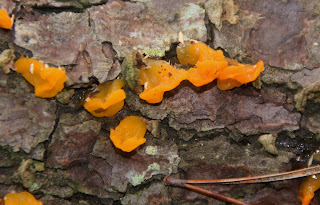Fall Fungus
GOING
NATURE’S WAY
By
Kate Crowley
If there is a silver
lining to be found in this very wet autumn, it is found in the forests. I’m not talking about the leaves, which are
very slowly turning color; I’m referring to the vast assortment of mushrooms on
the forest floor and on the sides of some trees. We just returned from a week’s hiking in the
Upper Peninsula of Michigan and I have to say, we have never seen such
abundance and variety in the Fungi Kingdom.
The people we were with, I’m happy to report, were just as excited as
Mike and I and demonstrated a sense of wonder that adults normally lose.
Overall, I prefer to
just observe the variations in shape, size, texture and color of
mushrooms. I do like to eat the types
sold in grocery stores and Morels are a favorite in the spring, but I have only
eaten a few ‘wild’ mushrooms and that only happened when I absolutely trusted
the knowledge of the person I was with.
In Europe people have been hunting, picking and eating wild mushrooms
for centuries and they have continued to pass down their knowledge to new
generations. Here in the U.S. it is far
less common and all of the books I have checked vehemently recommend that you
only collect with experienced mushroom hunters.
Field guides can give you some assurances, but there are still so many
slight variations between species, that it can be a game of Russian roulette.
There are somewhere in
the range of 10,000 species of mushrooms in North America, but in recent DNA
research, scientists are discovering that many species have been
misidentified. That is how subtle the
differences can be.
 I did say at the
beginning that the mushrooms were in the forests, but that isn’t really their
only habitat. They can be found in
fields, lawns, uplands and lowlands. We
were just out by Mike’s garden, where marigolds abound and growing in several
places beneath the flowers were Destroying Angels – a highly poisonous type of
Amanita mushroom. In our backyard under the clothesline, a single Fly Agaric
(poisonous Amanita) stood in all its orange-capped glory. A walk through our forest presented a wide
range of mushrooms, though not as many as we saw in Michigan.
I did say at the
beginning that the mushrooms were in the forests, but that isn’t really their
only habitat. They can be found in
fields, lawns, uplands and lowlands. We
were just out by Mike’s garden, where marigolds abound and growing in several
places beneath the flowers were Destroying Angels – a highly poisonous type of
Amanita mushroom. In our backyard under the clothesline, a single Fly Agaric
(poisonous Amanita) stood in all its orange-capped glory. A walk through our forest presented a wide
range of mushrooms, though not as many as we saw in Michigan.
In fact, what we call
mushrooms are just the fruiting body (like a nut or berry produced by a tree or
shrub) of the fungi. This is the part of the fungi that will disperse the
spores necessary for sexual reproduction. Most of the fungi actually exist
below ground in the form known as mycelium
which produce and secrete enzymes that digest organic matter. The cells that
make up the mycelium are described as hyphae and it is these cells that absorb
nutrients from the soil or wood.
Most everyone knows
that fungi/mushrooms help compost the detritus on the forest floor, especially
dead wood. Many fungi are specially
adapted to breakdown lignin, which is the cellulose found in trees. What is less well known is the critical
relationship between plants (that produce chlorophyll) and the mycorrhizal (which
means "fungus-root") fungi. This relationship exists in at least 90%
of all land plants, including all trees.
 This is a symbiotic
relationship between these two very different lifeforms. While the plants and trees can provide the
fungi with carbohydrates, produced through photosynthesis, the fungi helps by
dramatically increasing the absorption of water and certain essential minerals
through the tree’s roots. The tree (or
green plant) can access minerals such as phosphorus and magnesium, which would
otherwise be very hard to obtain. Many
species of mushrooms are highly specific to certain species of trees.
This is a symbiotic
relationship between these two very different lifeforms. While the plants and trees can provide the
fungi with carbohydrates, produced through photosynthesis, the fungi helps by
dramatically increasing the absorption of water and certain essential minerals
through the tree’s roots. The tree (or
green plant) can access minerals such as phosphorus and magnesium, which would
otherwise be very hard to obtain. Many
species of mushrooms are highly specific to certain species of trees.
In reality our world
would quickly fall apart without the presence of fungi. Such power encapsulated
in organisms that we barely notice under our feet. On your next walk through a woods or field,
see how many different kinds you can count.
And just enjoy their ephemeral splendor.
For a view of their growth through time lapse photography go to this
link: http://www.dailyliked.net/fantastic-fungi/




Comments
Post a Comment